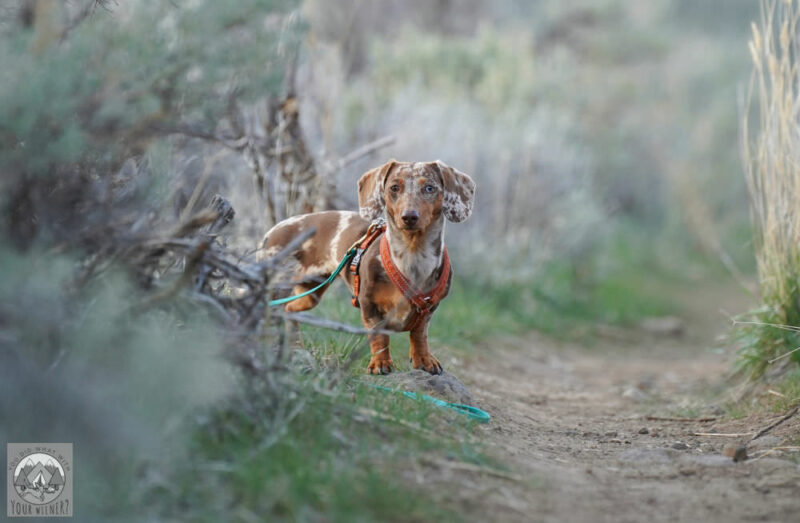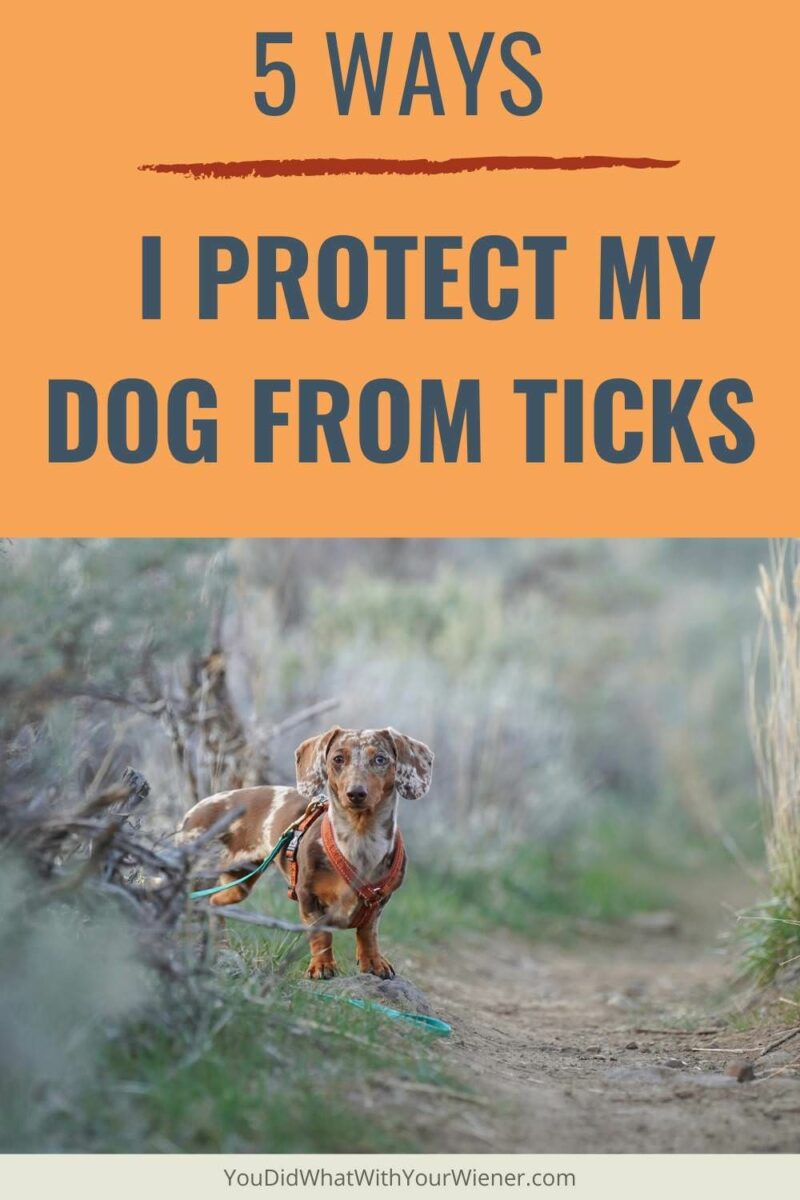I used to live in western Washington with my dogs where ticks are rare (although the encounters are increasing) but now we live eastern Washington where ticks are prevalent.
I’ve really had to increase my knowledge about ticks and learn how to prevent ticks on dogs.

Read: Why and Where You Need to Protect Your Dog From Ticks in Washington State
I’ve tried several products, and combinations of products, and found the 5 best ways to protect my dogs from ticks.
In this article, I share my tick safety protocol with you.
Disclosure: Some of the links in this article are affiliate links (Amazon Associate). As an affiliate, I earn a small commission from qualifying purchases.
How I Prevent Ticks on My Dogs – My Core Tick Protection Strategy
The primary ways I help prevent ticks from biting my dogs are always the same.
Using these three different methods for preventing and detecting ticks on my dogs gives me confidence because:
- The methods complement each other
- There is overlap and redundancy
- If one method fails (usually because I forget to do it), there are still two other ways my dogs are protected from ticks
Below are the three primary things I do for tick protection.
1) Apply topical flea and tick preventative
I choose to use a topical flea and tick preventative that not only kills ticks when they bite my dog but that also repels them.
I want one that works on contact so if ticks do get on my dog, they can die before they bite.
I do still want the treatment to kill a tick if it bites though in case the first two lines of defense fail.
In addition, I want to use a treatment that is effective against several different types of ticks, not just one like many of them are.
The three topical flea and tick treatments that meet my criteria, and that I use regularly, are:
My preferred brand of monthly flea and tick treatment is Vectra 3D (read my Vectra 3D review to see why).
Vectra 3D needs to be purchased at a Veterinarian’s office or online though.
In the past, if I didn’t plan ahead of time and needed the topical flea and tick treatment right away, I would stop at PetSmart and get K9 Advantix II.
I recently discovered TevraPet Activate II for Dogs, which contains the same ingredients as K9 Advantix II.
Although TevraPet Activate II has to be ordered online (I’ve never seen it in a pet store near me anyway), it’s less expensive than K9 Advantix II or Vectra 3D.
These treatments are sold in doses for dogs based on weight.
My small dogs, Summit and Gretel are 10.5 lbs so they fall right in between the smallest dose (4-10 lbs) and the next one up (11-20 lbs).
I use the larger dose if I know we will be hiking in an area where ticks are very bad that month (the primary difference is the amount of liquid in the tube/vial).
Whichever topical monthly flea and tick treatment I use, I don’t use it all year round.
I apply it to my dogs spring through fall when I know we will be hiking in places with ticks.
I will note that we live where it snows and the ground is frozen more often than not in the winter so the flea and tick risk is very low during the coldest months.
If you live somewhere that remains warm all year round, you probably want to use a flea and tick treatment all year round.
2) Perform regular tick checks
There is no substitute for regularly checking your dog for ticks.
No tick repellant or treatment is 100% foolproof, especially if ticks are particularly dense and it is toward the end of the topical 30 day treatment period.
Also, even though the topicals I use are sold as repellants, in my experience, my dogs can still pick up ticks (just presumably not as many as they would have without the topical treatment).
These ticks will die before they can transmit Lyme Disease because the monthly treatments I use kill the ticks that bite within 6 hours and ticks must be attached for over 24 hours to transmit it.
But, there are many other illnesses and diseases ticks can transmit within the 6 hours before they die so I want to remove them before they have a chance to bite.
I also don’t want them to fall off my dog in the car or house and roam around only to bite me or my dogs later.
I always check my dogs for ticks:
- After a hike before they get in the car
- When we get home
- Again in the morning
Where I look for ticks on my dog:
- In and around the ears
- Around the eyelids
- Under the collar
- In the arm pits of the front and back legs
- Between the toes and paw pads
- Around the tail
- Gums (in the mouth)
- Around the genitals
3) Feed garlic tablets made for dogs
Some consider it to be an old wives tale that the smell of garlic emanating from the body repels ticks and mosquitoes.
But, stories like these likely get perpetuated because they worked for enough people, in enough situations, to become a common recommendation.
I use the brewer’s yeast & garlic tablets from Only Natural Pet.
I can’t say with 100% certainty that garlic keeps ticks away from my dog.
However, we went for a hike once where my dogs had a topical tick treatment on, I had sprayed them down with a natural flea and tick repellent, and they were wearing an insect repellent dog bandana.
We hiked for 3 hours and when we got back to the car, I found 5 ticks on my dog. And they are very small so there isn’t much surface area!
Since I began feeding my dogs the garlic tablets, I haven’t found any ticks on them.
It could be coincidence – maybe we haven’t hiked in an area with a high tick density in the last 3 years or perhaps we’ve just been lucky – but I feel like the garlic tablets really do work to repel ticks.
In case you are wondering, I can’t smell the garlic. My dogs’ breath doesn’t smell like it and I don’t smell it coming from their body.
What I Do When I My Dogs Need Extra Protection from Ticks
The core prevention measures are the only ways I protect my dogs from ticks 90% of the time.
However, there are some situations where I may want even more protection.
In those cases, I do one or both of these two things.
4) Apply bug repellent spray
Sometimes we hike through a lot of brush where ticks cling and can be “scraped” off onto my dog’s belly.
In this situation, I want to add extra protection specifically to my dog’s underside.
For this, I use a picaridin-based (20%) insect repellent.
Picaridin is a synthetic version of pepper extract and its efficacy is considered comparable to DEET for mosquitoes and ticks (DEET should never be used on dogs though).
I should point out that picaridin has not been approved for use on dogs and you will find conflicting opinions on whether it’s safe for pets.
However, I found information that I think indicates that picaridin is likely safe for dogs.
For example, this article written by a veterinarian says, “… [picaridin] appears to have a wide margin of safety when used on dogs…”
According to the picaridin technical fact sheet by the National Pesticide Information Center, “Researchers placed technical grade picaridin at doses of 50, 100, or 200 mg/kg on the backs of beagle dogs every weekday for one year. The dogs demonstrated no adverse effects at any dose.”
Most “don’t use” recommendations I found appear to be made out of caution for liability since it’s not 100% tested to be safe on dogs.
Personally, I am comfortable using picaridin on my dogs because of this.
But, please, don’t take my opinion as a statement that it’s safe for your dog. Make your own decision.
I either use Natrapel wipes and apply it directly to my dog’s skin or I use the Natrapel spray.
If I use the spray, I apply it to my hands and then rub rub on their belly (I spray it on my hand first so they don’t inhale the mist).
If you would like to try an insect repellent spray that is more natural, I suggest trying Wondercide with cedar oil or Murphy’s Naturals Insect Repellent with lemon eucalyptus oil.
I have tried both of those on myself and my dogs and I didn’t find them as effective as picaridin but they did make a difference in the quantity of insects.
Using an insect spray is a good option if you only want to use a flea and tick treatment at specific times instead of using a treatment that lasts for a month because you’re not comfortable with that.
5) Put insect repellent clothing on my dogs
It’s usually not cool enough when we hike to put clothes on my dogs but this is a beneficial option when sitting around camp on cool evenings.
I treat my dog’s jackets with the Sawyer permethrin fabric treatment spray (and my own clothes).
Warning: Permethrin is toxic to cats!
Sometimes, I also treat their dog bed and blankets with permethrin.
I use the same method to treat my dog’s clothes and camping gear as I do when I make my own insect repellent dog bandanas.
When permethrin is applied to fabric, it molecularly bonds to it.
Note: This type of Permethrin should never be applied directly to your dog’s skin
You don’t have to treat your dog’s stuff yourself though.
There are products you can purchase that are pre-treated with permethrin such as:
The advantage of the commercially treated items is that the permethrin stays bonded to the material longer. Specifically, the claim is that it stays on the fabric through 70 washes.
The advantage of treating fabric myself is that I can use my dog’s regular jackets, shirts, bandanas, beds, blankets, etc. Stuff I know my dogs already know and love.
Treating the dog clothing myself at home with permethrin does mean I have to reapply it every 5 washes but for most items that will last a couple months.
What To Do If You Find a Tick Attached To Your Dog
If you discover your dog has been bit by a tick, don’t panic.
Remove the tick using a pair of tweezers like the TickEase Dual-Tipped Tick Remover Tweezers.
DO NOT burn, twist, or smother the tick.
Doing those things can cause the tick to spit more saliva into your dog, which carries any diseases a tick may have.
Watch this video for the proper way to remove a tick.
Wipe the tick bite location and around it with an alcohol swap to sterilize it.
Keep the tick in a sealed container while you keep an eye out for a bullseye rash or other signs and symptoms of lyme disease.
Also pay attention to how your dog is acting and call your vet immediately if you see signs that your dog might not be feeling well.
Keeping the tick:
Remember that prevention is the best way to pretect your dog from ticks.



Comments
Post a Comment